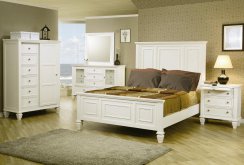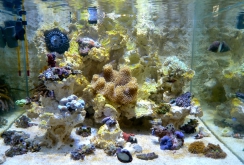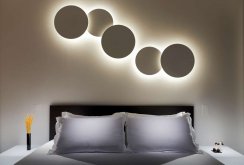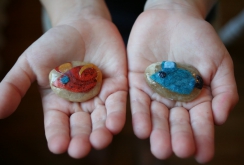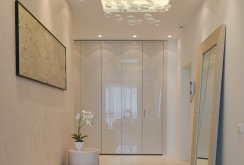Porcelain tile - new technologies from familiar ceramics
Ceramics is the oldest building and decoration material. Due to its unique properties, products from it never go out of fashion. Modern technologies made it possible to obtain new versions of ceramic mixtures with high performance and decorative qualities. One of these innovations is porcelain stoneware. Our review will allow you to find out all the features of this material necessary for the repair or decoration of a house, office or apartment.What porcelain consists of
The composition of porcelain stoneware will pleasantly surprise any connoisseur of environmentally friendly decorative materials. The basis for its creation is a slip - an aqueous suspension based on clay with additives of kaolin, quartz and feldspar. Each component of the mixture gives the raw materials certain qualities:- kaolin (white clay) has a binding ability and makes the composition refractory;
- quartz gives raw materials high strength and hardness;
- illite clays add plasticity and flexural strength to the composition;
- In addition to hardness, feldspar is highly chemical resistant.
- add mineral coloring pigments;
- molded products in the form of tiles with pressing and drying under pressure to remove excess moisture and air;
- apply drawing, glaze;
- burn at temperatures above 1200 °;
- grind and polish if necessary.
How durable is porcelain tile?
When creating porcelain tiles, the technologists were faced with the task of obtaining the most durable and solid material. As a result, porcelain stoneware has 7–8 points on the hardness scale, and is only slightly inferior to corundum and diamond. Surfaces lined with porcelain stoneware retain their original appearance for decades, since it is not susceptible to chips, cracks and scratches. Porcelain tile is indispensable for decoration of premises with heavy loads - production shops, shops and other public places with high traffic. The strength of porcelain is estimated by the thickness of the product and its structure:- A minimum thickness of 8 mm allows it to be used for wall cladding.
- Thicker tiles - up to 20 mm - are suitable for finishing floors.
- The thickened type of porcelain tile (up to 30 mm) withstands any load and is used to cover floors in industrial and public places.
Benefits of Using Porcelain Tile
In addition to its exceptional strength, porcelain stoneware has several other significant characteristics that distinguish it among modern finishing materials:- low coefficient of water absorption allows the use of porcelain stoneware for facing facades of buildings and premises with high humidity;
- a high degree of chemical inertness makes it suitable for all types of cleaning and decoration of premises where work is carried out with hazardous substances - various alkalis, acids;
- resistance to temperature extremes and ultraviolet radiation makes it possible to widely use tiles for the exterior decoration of buildings.
Types of Porcelain Tile
The industry produces porcelain tiles of several varieties for use in different conditions. Consider the most famous options:- Technical is used as flooring in production halls. It differs in a modest appearance and texture of the “salt and pepper” type. It has excellent strength indicators.
- Matte is not polished after firing. It is resistant to abrasion and does not slip, therefore it is convenient for facing stairs, porches, halls.
- Polished is obtained by grinding and polishing the top layer. The resulting mirror surface looks great and is easy to clean. For floors such porcelain tiles are not used because of the risk of slipping. It is widely used for wall decoration in any room.
- Lappated tiles are formed by partial grinding of the surface with special abrasives. The material is highly decorative, non-slip and popular for decoration of premises.
- Satin porcelain is obtained by coating with a layer of mineral salts before firing. The resulting tile has a soft, natural sheen, but does not slip.
- Glazed has a pattern or coating with colored glaze, which is applied before firing. Such tiles are used for the design decoration of apartments, restaurants, cafes.
- Structural tiles give a relief that imitates the surface of natural stone, wood, mosaics. The material looks very attractive and is widely used for decorative finishes.
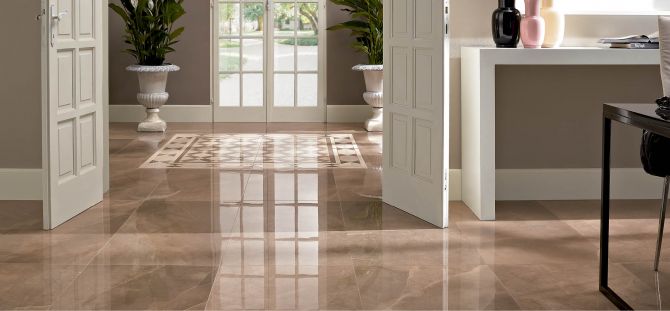
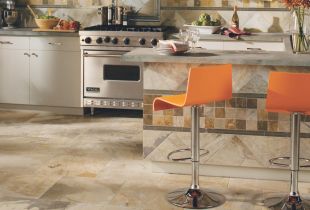 Porcelain tile for the kitchen - an elite surface finish (22 photos)
Porcelain tile for the kitchen - an elite surface finish (22 photos)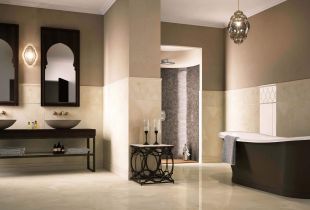 Porcelain tile in the bathroom: indestructible beauty (21 photos)
Porcelain tile in the bathroom: indestructible beauty (21 photos)